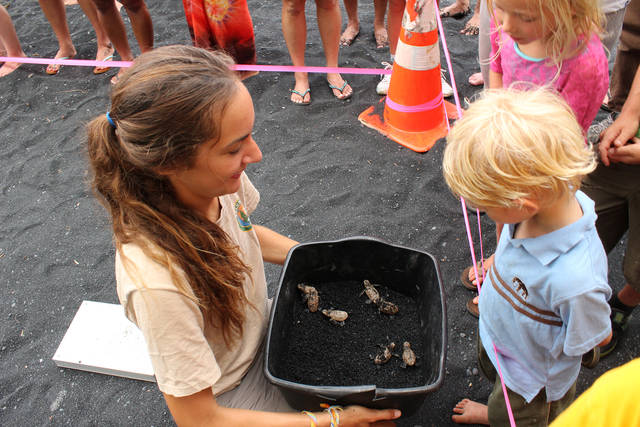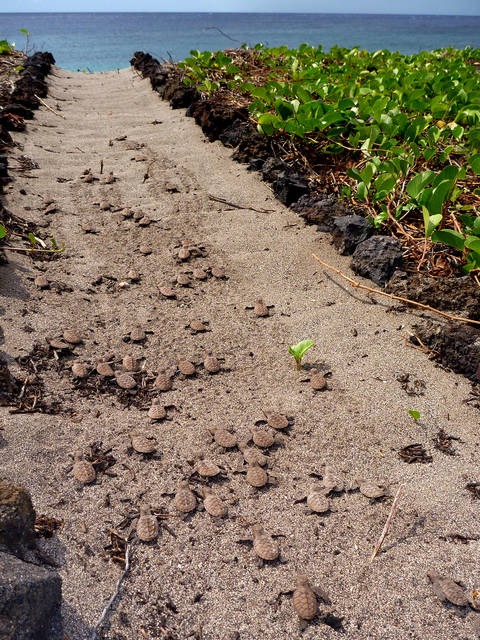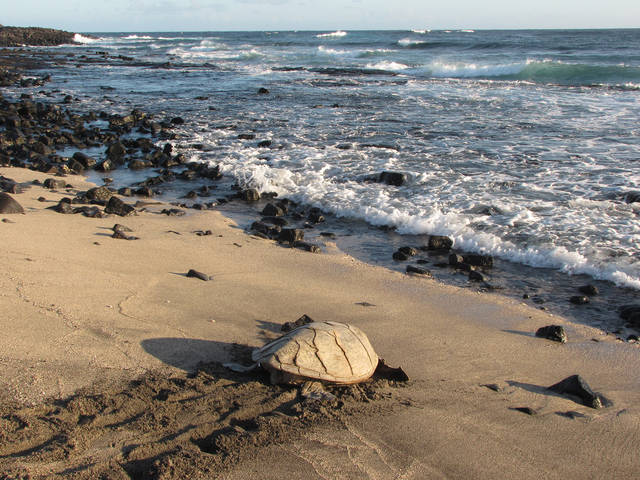Turtle monitoring efforts ramp up: Nesting season is a busy time for researchers
Early summer in Hawaii brings the start of a tale of two turtles.
ADVERTISING
Two species nest in the Hawaiian Islands — the green turtle (honu), which frequents beaches year-round as it basks, and the more elusive hawksbill turtle (honu‘ea), which comes ashore only to nest.
“There’s quite a difference between the two species we have,” said T. Todd Jones, a research biologist with the National Oceanic and Atmospheric Administration and leader of the Marine Turtle Biology and Assessment Program. The program conducts research throughout the Pacific islands, including the Mariana Islands, Rose Atoll and Samoa.
At this time of year, three researchers are camped out at the French Frigate Shoals, waiting for the honu to arrive at their nesting grounds. The science team will be there for up to five months, monitoring how many females come ashore, how many nests are dug, and how many hatchlings make it to the open ocean.
On a recent Thursday, researchers counted 35 nesting turtles in one night. As of last week, the team had observed close to 180 individual turtles, Jones said.
“It could be a bigger year out there,” he said.
Female green turtles can lay between two and seven nests per season, although turtles don’t nest every year. One female tracked by NOAA first laid eggs in the Northwestern Hawaiian Islands 38 years ago.
“Every two to five years she comes back to nest,” Jones said.
Ninety-six percent of all honu in the state head to the Northwestern Hawaiian Islands to lay their eggs.
“The Northwesterns have more sandy areas and sandy spits for them to nest on,” he said. Peak nesting season is in June, with some females continuing to lay eggs as late as September.
All species of sea turtles are protected under the federal Endangered Species Act. When they are at sea, those protections are implemented by NOAA. On land, turtles are under the jurisdiction of the U.S. Fish and Wildlife Service.
Honu populations have been increasing at a steady rate of about 5 percent annually since the 1980s, when federal protections were first put in place.
“We’re lucky in the sense that in Hawaii, people really value being able to see turtles,” said Michelle Bogardus, U.S. Fish and Wildlife Service team manager for Maui Nui and Hawaii Island. In other parts of the Pacific, turtle poaching is still a significant threat.
The NOAA turtle team estimates there are between 3,000 and 4,000 female honu, and an overall population of about 8,000.
“The Hawaiian green turtle is a success story,” Jones said.
The story of the hawksbill is a bit different. Federal protections went into effect for hawksbill turtles at the same time as for green turtles, but the population has remained the same through the years.
“Unfortunately, we’re not sure why,” said Lauren Kurpita, coordinator of the Hawaii Island Hawksbill Turtle Recovery Project.
The project is one of NOAA’s partners in the area, which also include USFWS, the state Department of Land and Natural Resources, Hawaii Wildlife Fund, National Park Service and University of Hawaii.
Jones said the hawksbill problem is being studied, but with little clues as to why numbers aren’t increasing.
“It could be different resources, different foraging habits,” he said.
The overall honu‘ea population in the state is estimated to be between 200 and 300. Since tagging of turtles began in 1991 on the Big Island, just 150 females have been identified.
“It’s a very small population,” Kurpita said. “We only deal with the nesting females, so I don’t ever see the males because they spend their whole lives in the ocean.”
Hawksbill turtles nest on Maui and the Big Island, primarily along the southern coast in Ka‘u. The Hawaii Island volunteer team found its first nest two weeks ago.
“Any help that we can get from the community in reporting the nests is good,” Kurpita said.
Hawksbills nest above the high-tide line, among vegetation (particularly naupaka). The nests themselves tend to be well-camouflaged, but the tracks from the shore are visible.
“If people were out at a beach and they did see tracks going into the vegetation … give the office a call,” Kurpita said.
Last year, the team got a call from a community member who saw eggs being washed to sea by high surf at Waipio Valley. The turtle crew was able to translocate the remaining eggs farther inland.
People camping along the southern beaches also are asked to minimize use of white light, which disorients female turtles and hatchlings.
“Without human influence, the brightest thing would be the moonlight reflecting on the water,” Kurpita said. That’s what guides hatchlings to sea, but if other light is present, the youngsters could head inland instead.
“Keeping our beaches dark is a positive thing for turtles,” Jones said.
The bigger threat to Hawaii’s sea turtles, particularly honu, is a looming one.
The Northwestern Hawaiian Islands are only a couple of feet above sea level, making them vulnerable to rising oceans.
“Their primary nesting habitat is on islands that are not likely to be around forever,” Bogardus said. “Unless turtle nesting (sites) can really be secured … on the islands that are higher, that is really going to be the conservation challenge for turtles — for greens, anyway.”
Hawksbill nesting sites are not as susceptible to sea-level rise.
Climate change also could impact turtle populations by literally changing the populating makeup. Turtle gender is determined by the temperature inside of a nest. Warmer nests mean an increase in the number of female turtles.
“That could be good at first, until you don’t have any males,” Jones said.
“It’s not something that we’re actively trying to manage at this point, but we’re keeping an eye on it,” Bogardus said.
Email Ivy Ashe at iashe@hawaiitribune-herald.com.





